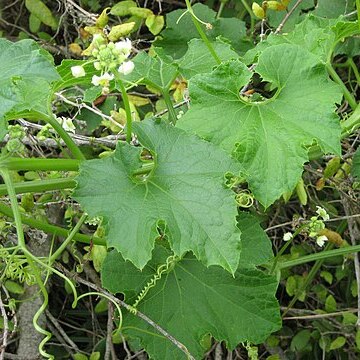Annual climbing or trailing herbs. Leaves simple; blade palmately lobed. Tendrils proximally 2–5-fid. Flowers small, greenish-white to greenish-yellow, monoecious. Male flowers few to many in simple or branched racemes, often ± whorled or subcapitate; receptacle-tube shallowly campanulate; lobes small, dentiform; petals (3–4–)5, united at the very base, entire; stamens (2–)3(–5); filaments inserted at base of tube, united into a central column; anthers united into a head, less often practically free; thecae arcuate, flexuous or triplicate. Female flowers solitary and long-pedicellate, or few to many subsessile and capitate at the apex of peduncles, smaller than (♂; perianth parts 5-merous, sometimes 3-merous; ovary ovoid and beaked or fusiform, 1-locular; ovule solitary, pendulous. Fruit rather small, ovoid and beaked or fusiform, terete, angled or compressed, aculeate, spiny or sometimes unarmed, dry and coriaceous or woody. Seed solitary, broadly ovate and compressed to fusiform, often rather obscurely bicarunculate at the apex; testa smooth.
Monoecious climbing or trailing annual herbs, hispid or pubescent with glandular hairs. Tendrils 2–5-branched. Leaves simple, palmately lobed. Flowers small. Male flowers in simple or branched racemes, often whorled or head-like; hypanthium broadly campanulate; calyx 5-lobed, the lobes small; corolla deeply 5-lobed, rarely 3-lobed, subrotate, white or greenish; stamens 2–5, inserted at base of hypanthium; filaments united into column; anthers united into head, rarely free; locules flexuose; disc absent. Female flowers in pedunculate heads or solitary; perianth similar to male, mostly smaller; staminodes absent; ovary ovoid, attenuate; ovule 1, pendulous; disc absent. Fruit dry, ovoid, attenuate, mostly bristly. Seed 1, ovate, compressed.
5-toothed; corolla salverform, the limb 5-lobate, spreading; stamens 3 (rarely 2 or 5), the filaments connate; anthers connate or free, the theca flexuous to nearly straight. Pistillate flowers in sessile clusters or in short pedunculate umbelloid heads, borne in the same axils as the staminate flowers; ovary ovoid to fusiform, setose or aculeate, rarely unarmed, l-celled, the ovule solitary, pendulous, the style subequalling the corolla tube, the stigma broad, 2-to 3-lobate. Fruits dry, ovoid, echinate, spiny, or rarely unarmed; seeds conforming to the locule, the testa reticulate or pitted.
Monoecious; fls 5-merous; cal small, 5-toothed; cor rotate, 5-lobed; anthers and filaments united into a column; ovary unilocular, with 1 suspended ovule; stigmas 3; fr dry, indehiscent, not inflated, covered by prickly bristles; annual vines with branched tendrils, broad, angular or lobed lvs, and small, white of greenish fls, the pistillate in small capitate clusters, the staminate in corymbiform racemes. 15, mainly trop.
Monoecious, tendriled vines; stems 5-to 10-angled or-sulcate. Leaves, peti-olate or the uppermost sessile, subentire or deeply lobate; tendrils 3-to 5-branched. Staminate flowers in racemes, panicles or umbelloid clusters, inflo-rescences long pedunculate; calyx shallowly and broadly campanulate to rotate,
Monoec. scrambling or climbing herbs; petals united at base, anthers cohering; ovary 1-locular, ovule 1, pend.; stigmas 3. Fr. ovoid, dry, ind., beset with barbed bristles. Some 30 spp. of America, Polynesia, Australia. The N.Z. sp. has the range of the genus.

